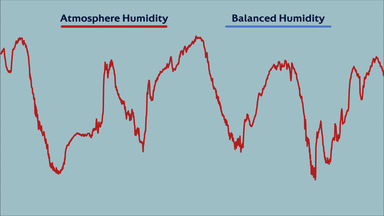 |  |  |
|---|
The science behind Humidity Power
DISCOVER
SUMMARY OF INNOVATION
Wind and solar energy are everywhere and we have learned to harvest them and transform these sources of energy into forms that are easily usable. Changes in the relative humidity of the air also “arrive at our doorstep” and there are significant amounts of energy that can be harvested from them. Our technology concerns a novel way to use this energy, a source that has been largely overlooked even in this age of environmental awareness and emphasis on renewable sources.
Our patent-pending innovation uses the disparity between dry and wet conditions of the air, by storing the ‘dryness’ or ‘wetness’ in a hygroscopic material. When the surrounding air is drier or wetter than the hygroscopic material, the potential energy difference between moisture in the air and that in the material can be used as a way of transporting heat from the material to the air and vice versa. One way this energy can be used is for heating and cooling of a building, averaging daily or seasonal changes in temperature and humidity. For example, a large storage of adsorbing material can be dried in the heat of summer, and allowed to re-adsorb water in the cold winter months, thus gaining heat that can be used for domestic heating.
Excerpt from our patent application

THE BASIC
TECHNOLOGY

To understand the basis of our technology we can first take a look at the daily humidity and temperature cycles. They are mirror images - in the early morning when the temperature is lowest, relative humidity level is the highest; at noon when the temperature is highest, relative humidity is lowest. If we constantly pass ambient air through our system, these changes are smoothed out, such that the peaks and troughs in both temperature and humidity cycles are shallower. A natural absorbent material inside our system releases humidity when the ambient air is dry, and absorbs humidity when the ambient air is moist, creating a more comfortable and safer environment.
"Long-term experiments showed that a system exploiting daily humidity fluctuations (our basic system) halves daily temperature extremes and reduces daily humidity extremes to ⅛ of their original values."
Temperature Balancing Short term experiment

Temperature Balancing Long term experiment

Humidity balancing occurs alongside temperature balancing: the system naturally cools when the temperature increases and heats when the temperature drops - all using only the negligible amount of energy required for moving air. When the temperature rises the air is dryer (its relative humidity decreases), and when this dry air passes through a moist material, the air cools as water evaporates into it. Our system absorbs moisture from the air in the nighttime, and is thus ready to perform cooling in the daytime. The reverse process is used for heating - when moisture from humid air adsorbs onto a dry material, heat is released into the air. Our material dries out in the daytime, and is thus ready to perform heating in the night. This cycle (which occurs on daily and seasonal time scales) can be repeated without limit, only energy input needed being that for blowing ambient air.
Humidity Balancing Short term experiment

Humidity Balancing Long term experiment

Summary of the daily temperature and humidity balancing mechanism
temperature rises → lowering humidity → evaporation cooling → reduce temperature rise
temperature falls → rising in humidity → absorption heating → reduce temperature fall
daily temperature and humidity balancing
SMART
CONTROLLER
Discover our smart control system
The system described above constantly streams ambient air. But we can also control the flow of incoming air, to selectively harvest just the right humidity conditions and activating the system for heating or cooling exactly when it’s needed.
By selectively storing and activating, our control system can widen the gaps between dry and wet conditions, increasing its efficacy.
Our controller “forages” for the highest humidity peaks, and stores those conditions for the moments when it is needed. In this way, the system can provide a temperature change of 15 degrees and more, for heating and cooling.
The system can also store dryness or moisture for long periods, without leaks. Our material can store 30 times more energy that can be stored in the thermal mass of concrete at the same weight.

Simulation Tool
ENERGY STORAGE
We use changes in the relative humidity of the ambient air to charge a thermochemical energy store. This store can then be used for heating and cooling buildings, for commercial and domestic applications.
The most simple form of thermochemical storage can be described by the following pair of reactions:
AB+Heat → A+B Charge
A+B → AB+Heat Discharge
Where a working material AB is heated until A and B are separated. When heat is desired, A and B are recombined in an exothermic process to give AB and heat (Abedin and Rosen 2012/5).
In our case, we use a natural absorbent material as A and water vapour in the air as B.
The energy of absorption is the heat of evaporation plus the binding energy, which for our basic absorbent material is about 3500KJ/KG.
One liter of water that changes state can thus release or absorb about 1 KW/h of energy.
AB+Heat → A+B Charge
A+B → AB+Heat Discharge
COMFORT ZONE
Our thermal comfort consists of a combination of temperature and humidity. Heating and cooling systems are often used to affect temperature only, sometimes at the expense of worsening humidity conditions. For example, air conditioners can heat but at the same time can create a sense of dryness that brings us out of healthy/comfortable humidity conditions.
We think in a different way -
we think about thermal comfort.
Our core technology can affect temperature and humidity simultaneously and our algorithm can choose which strategy is best given current conditions: changing humidity, changing temperature, or combining them.
In this way we keep the thermal conditions as close as possible to the comfort zone desired.

